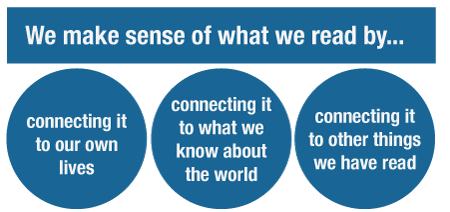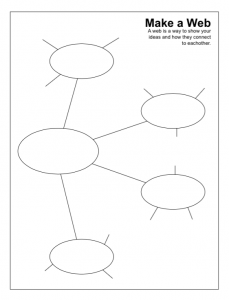Unit 1: Mysteries in BC History
Searching for Sasquatches
Reading Strategy
![]() In this unit, you will learn some strategies you can use before you read. These are called pre-reading strategies. One pre-reading strategy is called Connect.
In this unit, you will learn some strategies you can use before you read. These are called pre-reading strategies. One pre-reading strategy is called Connect.
First you ask: What is the subject of the reading? Subject is another way of saying “main topic.”
Then you ask: What does this subject remind me of?
Here is why this strategy works:
The subject of the reading in this chapter is the sasquatch. Another name for the sasquatch is Bigfoot.
When you think of a sasquatch, what are you reminded of? You will make a web to show the different ways your mind connects to the word sasquatch.
Make a web
1. Ask your instructor for the Make a Web sheet, or open and print one from the link. For this task, use a marker or pen.
2. Write sasquatch — the subject — in the big shape in the middle.
3. In each of the smaller shapes, write one of these questions:
a. What does it look like?
b. Where does it live?
c. Why do people think it is real?
d. Where have I heard about it?
4. Add your ideas to the lines around each question.
You will return to your web after you read Searching for Sasquatches.
Word Attack Strategy
Sometimes we see a word that we do not understand. Knowing lots of word attack strategies helps us make sense of the word. One word attack strategy is to study word patterns. Here are helpful word patterns to know.
Word Patterns
The letters –dge like in judge make the /j/ sound. The d is usually silent.
The letters –tch like in sasquatch make the /ch/ sound. The t is usually silent.
These patterns are only found at the end of a word or syllable or after a short vowel.
Practice reading these words
|
/j/ = -dge lodge fudge badge wedge |
/ch/ = -tch witch hutch fetch match |
You will see these patterns in the reading for this chapter.
Use Your Strategies
Read Searching for Sasquatches in your reader. When you have finished, try the tasks below.
Finish your web
1. After you have read the text, close your eyes and ask: When I think of the word sasquatch, what new things come to mind?
2. Get a different colour of marker or pen. Add your new connections to the web you made at the beginning of this chapter.
Now look at all of your new connections! What do you think about the Connect strategy? Did it help you make sense of what you read? Rate this strategy in your notebook. How many stars would you give it?
One star means it did not help you. Five stars mean it helped you a lot.

Check Your Understanding
Write true or false for each statement
1. The sasquatch is two metres tall.
2. The sasquatch can run very fast.
3. The sasquatch uses its hands and feet to walk, like an ape.
4. The sasquatch does not have a good smell.
5. People in British Columbia are allowed to hunt sasquatches.
Answer these questions
Who
6. …told a judge he was kidnapped by a sasquatch?
7. …was the reporter who researched sasquatches?
8. …has told stories about sasquatches for thousands of years?
Where
9. …is the Land of the Sasquatch?
When
10. …do scientists say a beast like a sasquatch once lived?
Use your vocabulary
11. Here are some vocabulary words from the reading. Try writing your own sentence for three of the words.
| beast | protected | exist | ape |
| proof | carvings | search |
Grammar
Let’s get ready to do some writing. When you write, it helps to know about subjects and verbs. This will help you know whether the sentences you write are complete sentences.
You know that a sentence begins with a capital and ends with a period, question mark or exclamation mark. Here is another rule about what every sentence needs.
Grammar Rule
A sentence needs a subject and a verb.
The subject tells us who or what the sentence is about.
The verb tells us what the subject is doing. A verb can be an action verb, like run or yell. A verb can also be a state verb, like be or have.
Ostman told a reporter that he was kidnapped by a family of sasquatches.
The sasquatch family held him at their camp.
The sasquatch is a big and hairy beast that looks like an ape.
And it smells very, very bad.
Stories of the sasquatch are not new.
Use the sentences above to answer these questions
1. Which statement is true?
a. In each statement, the subject comes before the verb.
b. In each statement, the subject comes after the verb.
2. Which statement is true?
a. The subject is always at the beginning of the sentence.
b. The subject is not always at the beginning of the sentence.
3. Which statement is true?
a. The subject is always just one thing.
b. The subject can be one thing or a group of things.
Copy these sentences, underline the subject, circle the verb
4. John Green researched stories about the sasquatch.
5. The sasquatch stands three metres tall.
6. Harrison Hot Springs is a place in the Fraser Valley.
7. The government of Harrison Hot Springs started a search party to look for the beast.
8. Scientists know an ape three metres tall did exist 200,000 years ago.
Seeing subjects and verbs in your sentences
9. Now write two or three sentences of your own. Write about whether you think the sasquatch is real. Give your reasons.
10. Underline the subject in each sentence. Circle the verbs.
Writing
Writing Task
![]() In everyday life, we often need to fill out forms. Imagine you are going on a trip to search for a sasquatch.
In everyday life, we often need to fill out forms. Imagine you are going on a trip to search for a sasquatch.
1. Ask your instructor for the Sasquatch Searchers forms, or open and print them from the link.
2. Fill out these forms to sign up for your trip. Print as neatly as you can.
3. Use a dictionary to look up any words you do not know.
4. When you are done, hand in your forms to your instructor.
Answer Key
| Check Your Understanding | |
| QUESTION | ANSWER |
| 1 | false |
| 2 | true |
| 3 | false |
| 4 | true |
| 5 | false |
| 6 | Albert Ostman |
| 7 | John Green |
| 8 | First Nations people |
| 9 | Harrison Hot Springs |
| 10 | 200,000 years ago |
| 11 | Answers will vary. |
| Grammar | ||
| QUESTION | ANSWER | |
| 1 | a | |
| 2 | b | |
| 3 | b | |
| SUBJECT | VERB | |
| 4 | John Green | researched |
| 5 | the sasquatch | stands |
| 6 | Harrison Hot Springs | is |
| 7 | The government of Harrison Hot Springs | started |
| 8 | scientists | know |
| 9 | Answers will vary. | |
| 10 | Answers will vary. | |




